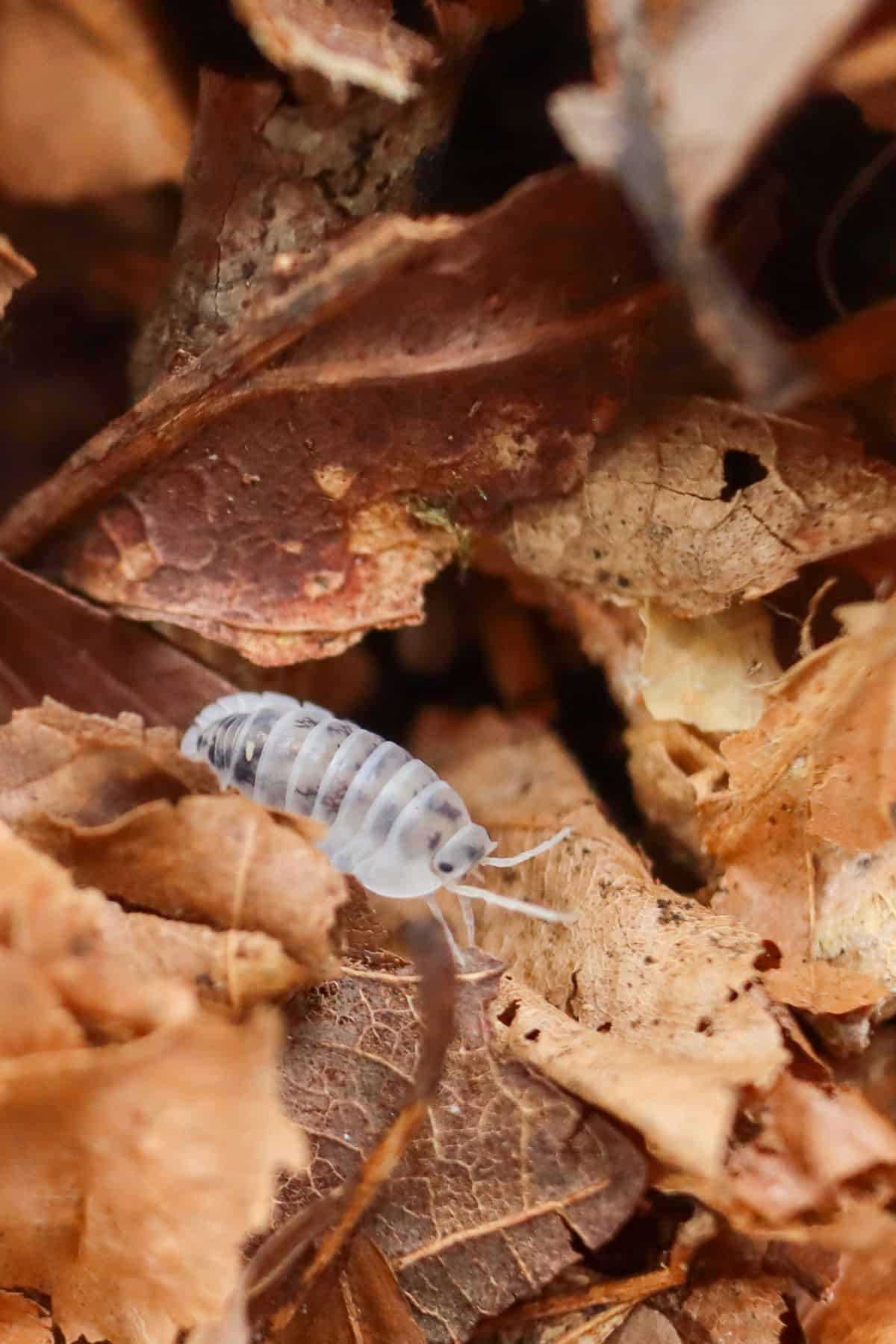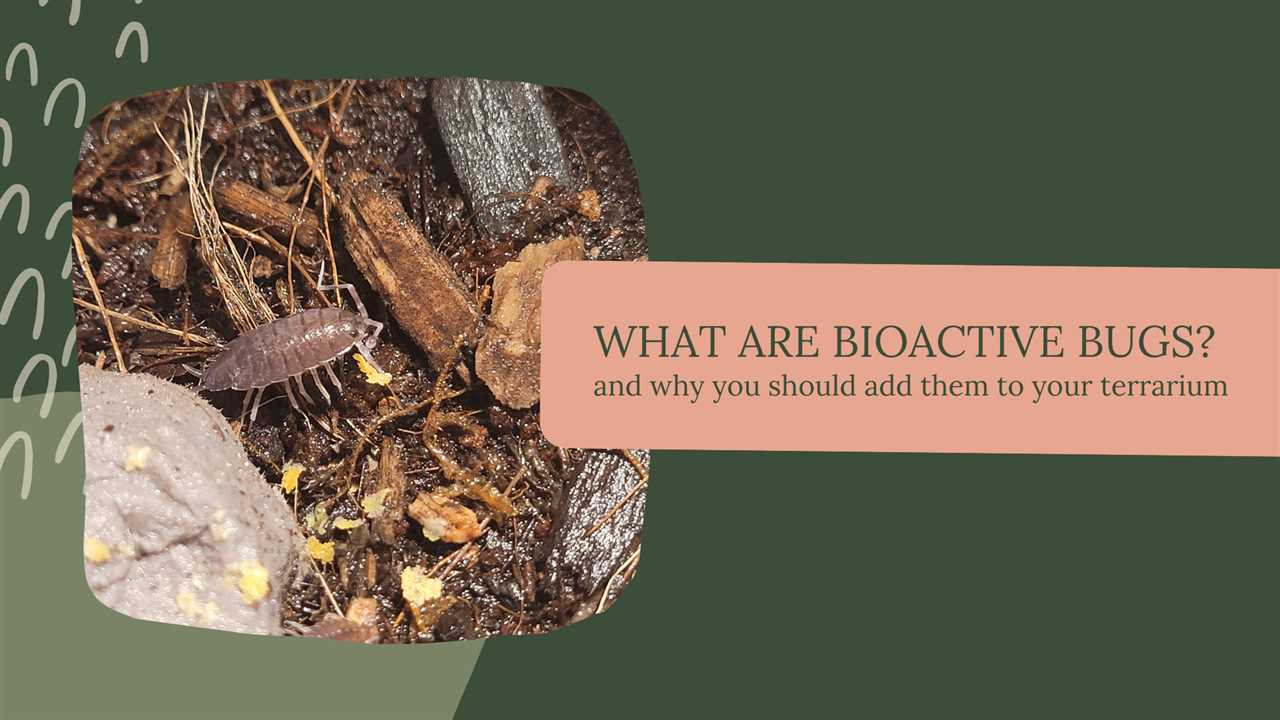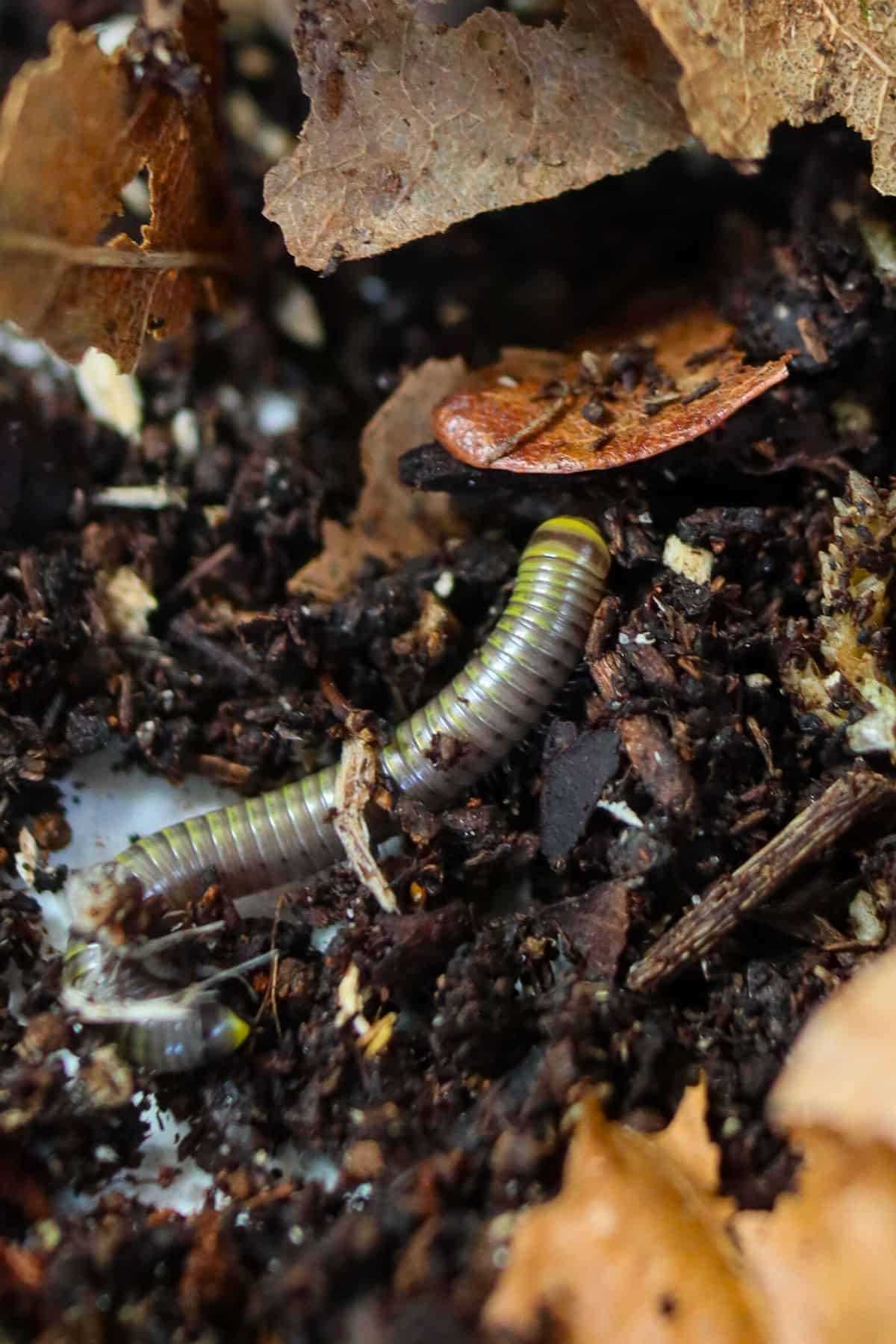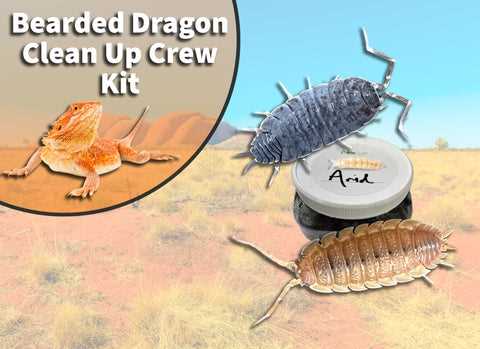
If you’re a reptile enthusiast, you know that creating the perfect terrarium environment for your scaly friends is essential. One way to enhance their living space is by introducing bioactive bugs into the terrarium. These little creatures play a vital role in maintaining a thriving ecosystem and providing numerous benefits for your reptiles.
What exactly are bioactive bugs? They are a diverse group of invertebrates that help to break down waste, control pests, and provide a natural food source for your reptiles. Some commonly used bioactive bugs include springtails, isopods, and millipedes, each playing a unique role in the terrarium ecosystem.
Springtails are tiny, spring-like bugs that thrive in moist environments. They feed on decaying matter and fungi, helping to break down waste in the terrarium. Additionally, they serve as a valuable food source for small reptiles like dart frogs and baby geckos.
Last but not least, we have millipedes. These multi-legged creatures are excellent decomposers, breaking down organic matter within the terrarium. They help to maintain a healthy balance in the ecosystem and prevent the build-up of waste. Millipedes are not only beneficial for waste management but are also a fascinating addition to any reptile habitat.
Bioactive Terrarium Bugs: Creating a Thriving Ecosystem for Your Reptiles
When setting up a terrarium for your reptiles, it’s essential to create a thriving ecosystem that mimics their natural habitat. One way to achieve this is by introducing bioactive terrarium bugs.
The Importance of Bioactive Terrarium Bugs
Introducing bioactive bugs into your terrarium has several benefits. Firstly, they help in the decomposition process by feeding on organic matter, including feces and uneaten food. This helps prevent the buildup of waste, keeping the terrarium clean and reducing the risk of bacterial growth.
These bugs also contribute to soil aeration, which promotes healthy plant growth. They burrow and move through the substrate, creating tunnels that allow air and water to penetrate, ensuring the roots receive adequate oxygen and nutrients.
Selecting the Right Bug Species
Choosing the appropriate bug species for your terrarium depends on various factors, including the size of the enclosure, the reptile species, and the desired ecosystem. Some commonly used bugs in bioactive setups include springtails, isopods (such as dwarf white isopods or powder orange isopods), and beetles (like darkling beetles or mealworm beetles).
It’s essential to research each bug species and understand their specific roles in the ecosystem before introducing them to your terrarium. Each bug has unique characteristics and functions that contribute to the overall balance and health of the terrarium ecosystem.
Providing Proper Nutrition
In order to sustain the population of bioactive bugs, it’s crucial to provide them with a suitable food source. Typically, these bugs feed on decaying organic matter, including leaf litter, wood, and fruit. Adding these food sources to your terrarium helps ensure the bugs have access to a balanced diet.
Creating a Balanced Habitat
Creating a balanced habitat involves providing the right substrate, humidity, temperature, and vegetation for both the bugs and your reptiles. The substrate should be suitable for burrowing bugs, while the humidity and temperature levels should mimic the natural conditions of the reptile’s habitat.
In terms of vegetation, adding live plants to the terrarium not only enhances the aesthetics but also provides additional hiding spots and food sources for the bugs. Plants like ferns, bromeliads, and snake plants are commonly used in bioactive setups and contribute to the overall ecosystem’s health.
Monitoring and Maintaining Population Levels
If the population of bugs becomes too large, it may be necessary to remove some individuals or introduce natural predators to keep the numbers in check. Conversely, if the population decreases, additional bugs may need to be added to maintain a healthy ecosystem.
Regular spot cleaning of the terrarium, removing any excessive waste or uneaten food, also helps maintain optimal conditions for the bugs and reptiles.
Benefits of Bioactive Terrariums
Setting up a bioactive terrarium has numerous benefits. Besides creating a more natural and aesthetically pleasing environment, bioactive terrariums reduce the need for frequent cleaning and maintenance. The bugs contribute to waste management, soil fertility, and overall ecosystem stability.
Furthermore, introducing bioactive terrarium bugs can lead to enhanced reptile behavior and overall well-being. The presence of live insects provides a more stimulating and natural environment for the reptiles, promoting natural behaviors like hunting and foraging.
Compatibility with Different Reptile Species
While bioactive terrariums can be beneficial for various reptile species, it’s essential to consider the specific needs and behaviors of your reptile before incorporating bioactive bugs. Some reptiles, such as arboreal species, may not interact with the bugs as much as ground-dwelling species.
Common Mistakes to Avoid
When creating a bioactive terrarium, there are several common mistakes to avoid. These include overpopulating the terrarium with bugs, using inappropriate bug species that may harm your reptile, or neglecting to provide a suitable food source for the bugs.
The Importance of a Natural Ecosystem in a Terrarium

A bioactive terrarium is an enclosed environment that replicates a natural ecosystem for reptiles, complete with living organisms such as plants, bugs, and microorganisms. Creating a thriving ecosystem within a terrarium is essential for the health and well-being of reptiles, as it provides them with a more natural and stimulating environment.
| Benefits of a Natural Ecosystem in a Terrarium |
|---|
|
Overall, creating and maintaining a natural ecosystem in a terrarium is not only beneficial for the reptiles but also for the overall balance and sustainability of the habitat. It allows reptile owners to provide a more natural and stimulating environment, which can enhance the health and well-being of their beloved pets.
Selecting the Right Bug Species

When creating a bioactive terrarium for your reptiles, one of the most crucial steps is selecting the right bug species. Bugs play a pivotal role in the terrarium ecosystem, contributing to the overall health and balance of the habitat.
Some common bug species that are suitable for bioactive terrariums include:
1. Feeder Insects: Crickets, roaches, mealworms, and waxworms are commonly used as feeder insects for reptiles. These bugs provide a good source of protein and are ideal for reptiles that primarily consume insects.
3. Springtails: These tiny, jumping insects are excellent cleaners in the terrarium. They consume mold and fungi, preventing their growth and maintaining a healthy environment for your reptile.
4. Beetles: Some beetle species, such as darkling beetles, can be beneficial in a bioactive terrarium. They help with decomposition and consume decaying organic matter, keeping the habitat clean.
When selecting bug species for your terrarium, it is essential to consider their compatibility with each other. Some bugs may not coexist peacefully and may even prey on each other. Research the behavior and compatibility of different bug species to ensure they can thrive together in the terrarium.
Additionally, you should also consider the size and activity level of the bugs. For smaller reptiles, such as geckos, smaller bugs like fruit flies or pinhead crickets may be more suitable, while larger reptiles may require larger bugs like adult crickets or roaches.
Providing Proper Nutrition for Bioactive Terrarium Bugs
Selecting the Right Bug Species
Some common bug species that are typically included in bioactive terrariums include springtails, isopods, and roaches. These bugs are not only great decomposers, but they also provide a source of protein for your reptiles.
Feeding the Bugs
Supplementing with Calcium
You can provide calcium supplements in the form of powdered calcium or by offering calcium-rich foods such as cuttlebone or eggshells. Providing a calcium source will help ensure that your bugs are getting the necessary nutrients to thrive and reproduce.
Creating a Balanced Habitat in a Bioactive Terrarium
Here are some important steps to take in order to achieve a balanced habitat:
- Proper Substrate: Use a substrate that mimics the natural environment of the species you are keeping. This can include a mixture of soil, sand, and organic matter to provide the right texture and moisture levels.
- Plant Selection: Choose plants that are suitable for the terrarium and the reptiles you are keeping. Plants not only serve as hiding places and climbing structures for your reptiles, but they also contribute to the overall balance of the ecosystem by oxygenating the air and providing food for the bugs.
- Water Source: Ensure that a clean water source is available for both your reptiles and the bugs. This can be in the form of a shallow dish or a dripping system. Maintaining proper humidity levels is also essential.
- Preventing Overpopulation: Monitor and maintain population levels of the bugs living in the terrarium. Too many bugs can lead to competition for resources, while too few may not provide enough food for your reptiles.
- Consistent Maintenance: Regularly inspect and clean the terrarium to maintain a healthy environment for both your reptiles and the bugs. Remove any decaying organic matter or waste to prevent the buildup of harmful bacteria.
By following these steps, you can create a balanced habitat in your bioactive terrarium, providing a thriving ecosystem for both your reptiles and the bugs. This ensures the long-term health and well-being of your pets, while also creating a visually stunning and naturalistic display.
Monitoring and Maintaining Population Levels
Monitoring can be done by visually observing the terrarium and keeping track of bug sightings. You can also use sticky traps or pitfall traps to capture and count the bugs to get a more accurate population estimate.
Maintaining the bug population levels involves providing proper conditions for their reproduction and survival. This includes creating suitable hiding places, providing enough food and water sources, and ensuring the right temperature and humidity levels in the terrarium.
If you notice that the bug population is declining, it may be necessary to intervene and provide additional food or adjust the conditions in the terrarium. On the other hand, if the bug population is growing too rapidly, you may need to consider reducing the amount of food provided or removing excess individuals to maintain a balance.
By monitoring and maintaining population levels of bugs in your bioactive terrarium, you are helping to create a self-sustaining ecosystem that benefits both your reptiles and the bugs themselves. This natural balance can provide enrichment and stimulation for your reptiles, as well as promote their overall health and well-being.
Controlling Pest Insects in a Bioactive Terrarium
The Role of Pest Insects in a Bioactive Terrarium
Pest insects can cause various problems in a bioactive terrarium. They can damage plants, compete for resources, spread diseases, and even harm your reptiles. Therefore, it is crucial to identify and control them effectively.
1. Regular monitoring:
Monitoring the terrarium regularly can help you identify any signs of pest infestations. Look for unusual behavior in your reptiles, such as loss of appetite or skin irritation, as well as any damage to plants or unusual bug populations.
2. Natural predators:
Encouraging the presence of natural predators can help control pest insects. Introduce bug species that prey on the pests you want to control, such as predatory mites or beetles. These beneficial insects can help keep the pest population in check.
3. Biological controls:
4. Physical barriers:
Using physical barriers can help prevent pests from infiltrating the terrarium. This can include using fine mesh screens on ventilation openings or covering the substrate with a pest-proof material.
Maintaining a Healthy Ecosystem
Controlling pest insects is crucial for maintaining a healthy bioactive terrarium ecosystem. By implementing effective pest control strategies, you can ensure the well-being of your reptiles and create a balanced habitat for all the bugs in your terrarium.
Remember, it’s about finding the right balance between having enough bugs to support the ecosystem and keeping pest populations under control. With proper monitoring and management, you can enjoy the benefits of a bioactive terrarium while providing a safe and thriving environment for your reptiles.
The Role of Decomposers in the Bioactive Terrarium Ecosystem
What are Decomposers?
Types of Decomposers in Bioactive Terrariums
There are several types of decomposers commonly found in bioactive terrariums:
| Type of Decomposer | Description |
|---|---|
| Springtails | These small, wingless insects feed on decaying organic matter and fungi. They are excellent decomposers and help to control the growth of mold and other potentially harmful organisms. |
| Isopods | |
| Millipedes | Millipedes are arthropods that are highly efficient decomposers. They consume decaying organic matter and help to break it down into smaller particles, making it easier for other organisms to decompose further. |
Benefits of Decomposers in Bioactive Terrariums
Introducing decomposers into a bioactive terrarium offers several benefits:
- Improved nutrient cycling: Decomposers break down organic matter and release essential nutrients back into the soil, promoting healthy plant growth.
- Waste management: Decomposers help to manage waste by consuming dead plants, animals, feces, and other organic material.
- Control of harmful organisms: Decomposers compete with potentially harmful organisms, such as mold and fungi, for resources, helping to keep their populations in check.
- Increased biodiversity: The presence of a diverse range of decomposers enhances the overall biodiversity of the terrarium, creating a more natural and balanced ecosystem.
Overall, the role of decomposers in a bioactive terrarium cannot be understated. They are essential for maintaining the health and balance of the ecosystem, promoting nutrient cycling, and ensuring the overall well-being of the reptiles inhabiting the terrarium.
The Benefits of Bioactive Terrariums
A bioactive terrarium is a living ecosystem within a reptile’s enclosure that includes not only the reptile itself but also a variety of plants, microorganisms, and insects. This type of setup aims to replicate the natural habitat of the reptile while providing numerous benefits for both the reptile and the keeper.
One of the main advantages of a bioactive terrarium is that it creates a more natural and stimulating environment for the reptile. By including live plants, rocks, branches, and other natural elements, the terrarium mimics the reptile’s natural habitat, which can help reduce stress and promote overall well-being.
Bioactive terrariums also help maintain proper humidity levels. The plants and the microorganisms in the substrate help to regulate moisture, preventing dryness or excessive humidity. This is especially important for reptiles that require specific humidity levels to thrive.
Another benefit of having a bioactive terrarium is the diversity of the ecosystem. By including a variety of plants and insects, the terrarium becomes a mini ecosystem that supports and sustains itself. This can provide enrichment for the reptile as it can exhibit natural behaviors such as hunting or foraging for insects, climbing plants, or basking on rocks.
Furthermore, bioactive terrariums can improve the overall health of the reptile. The live plants contribute to the oxygenation of the enclosure, helping to purify the air and create a healthier environment. In addition, the presence of microorganisms in the substrate can promote beneficial bacteria, which can aid in digestion and prevent the growth of harmful bacteria.
Lastly, bioactive terrariums are aesthetically pleasing and can be an interesting and educational focal point in any room. Watching the reptile interact with its environment and observing the different plants and insects can be both therapeutic and educational.
Compatibility with Different Reptile Species
Research the Reptile’s Diet and Behaviors
Before introducing bugs into your terrarium, it is essential to understand the diet and behavior of your reptile. Some reptiles may not be interested in hunting bugs, while others may actively seek them out. Knowing your reptile’s preferences will help you select the right bug species that can coexist peacefully.
Consider the Size and Aggressiveness of the Bugs
Monitor Interactions and Make Adjustments
After introducing bugs into your terrarium, closely observe how your reptile interacts with them. If you notice any signs of aggression, stress, or discomfort, it may be necessary to remove or replace certain bug species. Regular monitoring of the terrarium will help you maintain a healthy and harmonious environment for your reptile.
Remember, the goal is to create a thriving ecosystem for your reptile, and bug compatibility is a crucial aspect of achieving that balance.
Common Mistakes to Avoid in Bioactive Terrarium Bug Control
1. Overpopulation of Bugs

2. Inadequate Pest Control
3. Lack of Diversity in Bug Species
Having a diverse range of bug species is important for maintaining a balanced ecosystem in your terrarium. Some bugs may serve as decomposers, while others act as scavengers or predators. By selecting a variety of bug species, you can ensure a more robust and self-sustaining ecosystem.
4. Improper Nutrition for Bugs
5. Neglecting Temperature and Humidity Levels
6. Overreliance on Chemical Controls
By avoiding these common mistakes in bioactive terrarium bug control, you can create a thriving and balanced ecosystem for your reptiles to enjoy. Taking the time to research and understand the needs of your bug species and implementing proper care practices will contribute to the overall health and longevity of your terrarium ecosystem.

I’m Lena Adams—a product of an unconventional upbringing in the African wilderness. My father, a daring explorer of African wildlife, sparked my fascination with reptiles, a passion that intertwined with the tragic loss of my mother during an expedition, leaving an indelible mark on my life. Driven to understand the creatures that captivated my parents, I embarked on my journey, sharing insights about reptiles, frogs, and lizards on my website. Through my explorations and conservation efforts, I honour my family’s legacy while seeking connections—to the creatures, nature, and the mother whose presence I yearn to understand.
